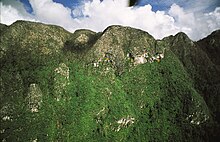Lubang Jeriji Saléh
[3] However, the same team has since found and dated an elaborate therianthrope rock art panel in the Leang Bulu' Sipong 4 cave in Sulawesi's Maros-Pangkep karst to around 44,000 years ago.
[1][2][6][7] The bull, that belongs to a trio of rotund bovine creatures is over 5 ft (1.5 m) across,[8] and also made from reddish-orange ochre on the cave's limestone walls.
A dating published in 2003 on a calcite formation covering 2 hand-prints had concluded to an age of 9900 years (U/Th combined with C14), which was the first proof of the belonging of this Borneo rock expression to the Pleistocene.
[14] The 2018 team of researchers and scientists, led by Maxime Aubert from the Griffith University, Australia and Pindi Setiawan from the Bandung Institute of Technology, Indonesia had investigated the site, identified and dated the rock paintings as the world's oldest known figurative art and published the results in the Nature journal by the end of the year.
[15][16][17] The team has since found and dated an elaborate therianthrope rock art panel in the Leang Bulu’ Sipong 4 cave in Sulawesi, to around 44,000 years old, according to a 2019 publication.

